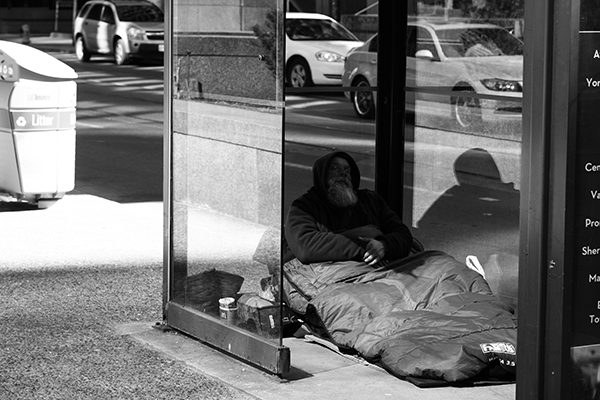
By Joy Portella, President, Minerva Strategies—
“Look – there’s one. No three!”
We saw a person. His large size indicated it was a man, and he was slumped over in a wheelchair and draped in a blanket. At his feet were two other people. We couldn’t discern their genders. They were huddled and “sheltered” in broken-down cardboard boxes. Everyone was still – absolute, eerie stillness.
We marked them on our tally sheets: one man in wheelchair, two gender undetermined.
We went on like this for two hours, wandering the streets of Seattle, counting the number of people sleeping outside. My teammates and I were three of hundreds of volunteers staffing the One Night Count, an effort run by the Seattle/King County Coalition on Homelessness to get a point-in-time snapshot of our area’s homelessness challenge. The Count provides data that helps politicians and planners make investments to combat homelessness. It’s also a community call to action, and kicks off a year of education and action.
The results of this year’s Count were startling: 4,505 people sleeping outside in King County, a 19% increase over last year. The Count came at a moment of heightened tensions over homelessness in Seattle. The Mayor’s strategy to tackle the problem has been under intensive fire from both despairing homeless advocates and impatient residents. Just two days before the Count, a deadly shooting of several homeless in Seattle’s I-5 Greenbelt, an area with the ominous pseudonym “The Jungle,” confirmed just how dangerous it can be to live outside.
On the streets of Denny Triangle last Thursday, I saw another narrative of Seattle’s homelessness being played out: The contrast of our city’s extreme wealth with people who are glaringly left behind. Denny Triangle is a once gritty no-man’s-land that’s changing quickly, as neighboring South Lake Union did before it. Glistening, high-end apartment buildings, chic boutiques, and lovely restaurants line many of the streets, and a gaping hole in the middle of the neighborhood marks the spot of Amazon’s newest neighborhood acquisition. Yet even in this increasingly shiny, wealthy area, the homeless are tucked in doorways and alleys, in pop tents, boxes, and sleeping bags – wherever they can find a spot.
Homelessness is a new issue for me. I’m learning all the time, and I don’t have answers. I’m inspired by Minerva’s clients who work in this space, and I haven’t yet wrapped my arms or mind around it. But I do have questions, lots of them, and initial observations.
The most startling thing I’ve noticed is the narrative of homelessness in Seattle, and how people struggle with it. I’ve written a lot about the oversimplification of hero-villain narratives in international development, and I see some of the same things happening with how we talk about the homeless.
People want to break the homeless down into two black-and-white groups:
- The “good homeless” – These are children and parents (usually mothers) who are victims of some kind of abuse or economic shock or both. They are struggling to get on their feet and find a permanent home. This is Will Smith in “The Pursuit of Happiness,” and who doesn’t want to get behind Will Smith?
- The “bad homeless” – These people are selfish and refuse shelter. They want to eschew society’s rules and live on their own terms, which hurts our community. They are dirty and take drugs and claim to be broke but still manage to own expensive smart phones. Why should we get behind these people?
The truth is that it’s not that simple. Sure there are “good homeless” and “bad homeless” because there are good people and bad people. But most homeless, like most people, don’t fit into extreme characterizations. They’re complicated. Many are struggling with mental health issues or drug addictions. Many have had difficult, unstable lives. Some would rather live on the streets – in what for them is relative stability – than be shuttled through a shelter system where they cannot be with their partners or their pets.
This is hard stuff. It’s not pretty, and it’s not going to be solved quickly with a short-term infusion of cash or grand public statements. It’s going to take work, and an ongoing examination of who the homeless are and how they can become more safe and stable.
We also need to examine ourselves as community and think about how we respond to these challenges. Do we engage or recoil? Do we listen and problem solve, or get angry? Do we put up not-in-my-backyard walls, or face the reality that nobody truly has their own backyard?
I have hopes for where we’ll wind up on the issue of homelessness, but I’m not sure how to get there. That’s why I’m listening, learning, and struggling with the issue. It’s a worthy pursuit because people’s lives are at stake, and they matter just as much as people who sleep in warm, comfortable beds.